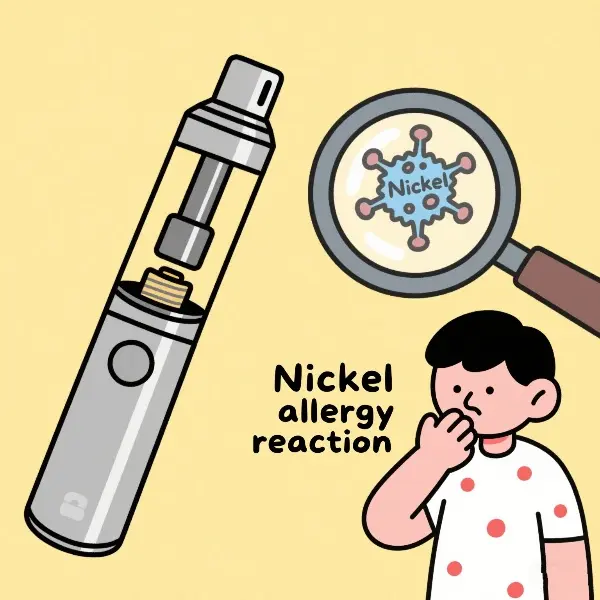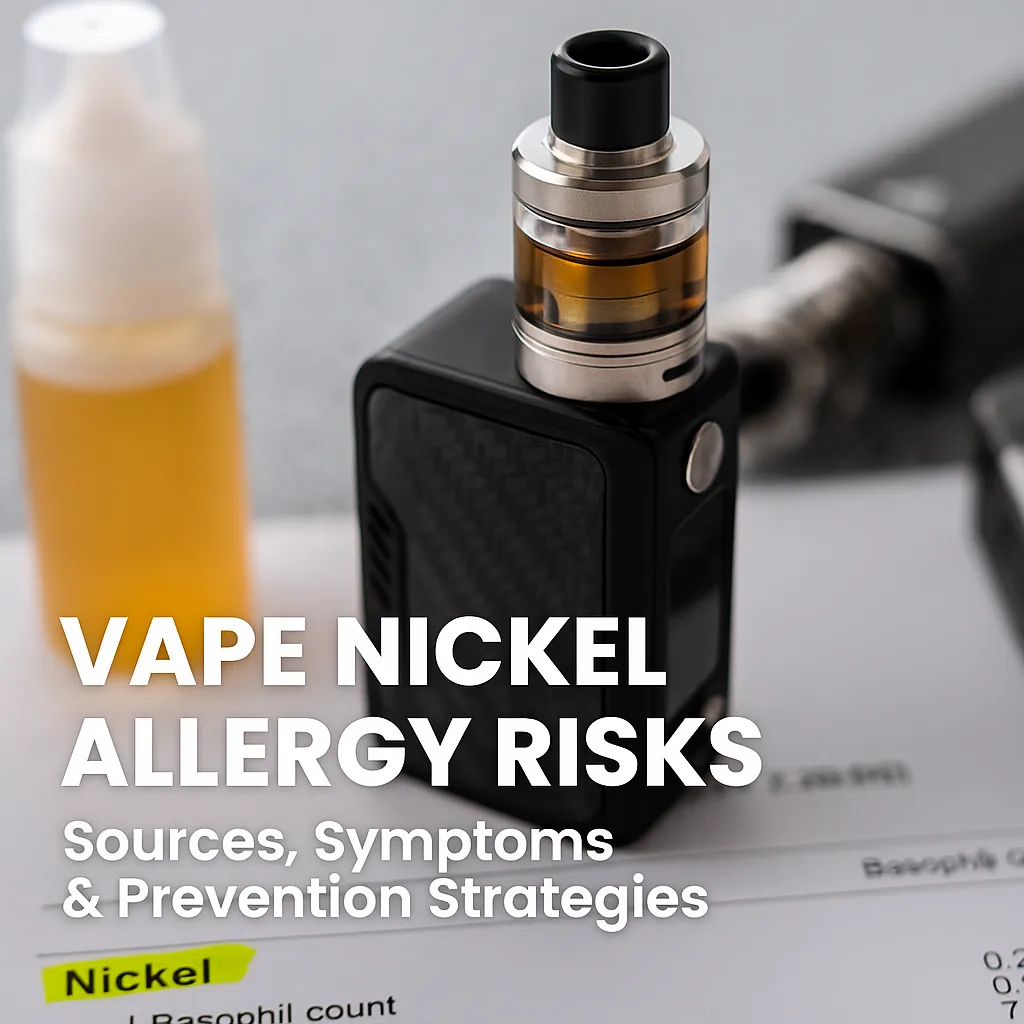Seguridad del material para vapear y riesgos para la salud: Análisis de las posibles controversias en torno a los componentes metálicos y las bobinas de los atomizadores
Riesgos de alergia al níquel en los componentes metálicos de Vape

Las piezas metálicas de los vaporizadores (por ejemplo, las bobinas del atomizador, la carcasa) pueden contener níquel y otros elementos que pueden ser perjudiciales para las personas sensibles a los metales. Este análisis examina cómo los vapeadores pueden provocar alergias a los metales, cuáles son los síntomas, cuáles son las pruebas científicas y qué medidas de protección pueden tomar los usuarios para evitar los riesgos. Artículo relacionado: "LOS CIGARRILLOS ELECTRÓNICOS COMO FUENTE DE METALES TÓXICOS Y POTENCIALMENTE CANCERÍGENOS“.
Vías invisibles de exposición al níquel
El níquel en los vapes procede principalmente de dos partes:
- Bobinas atomizadoras: Las bobinas tradicionales (por ejemplo, de aleación de nicromo) pueden liberar iones de níquel a altas temperaturas, especialmente cuando se desgastan los revestimientos superficiales o bajo alta potencia (>80W), aumentando el riesgo de lixiviación por 30%.
- Carcasa metálica y electrodos: Algunos materiales, como el acero inoxidable y las aleaciones de aluminio, pueden provocar irritaciones cutáneas si entran en contacto con el sudor durante mucho tiempo.
Síntomas típicos de la alergia al níquel
Aproximadamente el 15% de la población mundial puede tener alergia al níquel:
- Dermatitis de contacto: Erupción roja que pica o quema en la mano (el dorso de la mano y las yemas de los dedos) o en los labios cerca de la boquilla. Esto puede empeorar si sigues usándolo, y podría provocar ampollas o descamación de la piel.
- Reacciones alérgicas crónicas: Si te expones a ella durante mucho tiempo, puede engrosarte la piel, cambiarte el color o causarte problemas en todo el cuerpo (por ejemplo, problemas respiratorios). Pero estas cosas son raras.
Investigación científica y pruebas clínicas
- Pruebas de laboratorio: Algunas bobinas de vape de bajo coste superan los límites REACH de la UE (0,1μg/cm²/h) para la lixiviación de níquel, especialmente cuando se exponen a e-líquidos ácidos (por ejemplo, sabores frutales), que aumentan la lixiviación por 50%.
- Informes clínicos: A 2023 DermNet NZ un estudio documentó 3 casos de eccema de manos inducido por alergia al níquel debido a los componentes metálicos de los vapeadores.
Estrategia de protección en cinco pasos
- Evitar la fuente: Elija dispositivos certificados de bajo contenido en níquel
- Elija bobinas que no contengan níquel (por ejemplo, titanio puro o acero inoxidable 316L) y evite las aleaciones de nicromo Ni80.
- Preferiría que la carcasa fuera de plástico, resina o una aleación de titanio, para que haya el menor contacto posible con el metal.
- Aislamiento físico: Utilizar cubiertas protectoras
- Cubre las piezas metálicas con silicona o resina para evitar que entren en contacto con la piel.
- Cambia las boquillas por plástico alimentario para evitar que los labios toquen el metal.
- Hábitos de uso: Reducir el contacto prolongado
- No mantengas el artículo demasiado tiempo en tus manos. Además, asegúrate de limpiar regularmente las zonas de contacto con bastoncillos con alcohol.
- Utilice la carga sin contacto (por ejemplo, carga magnética) para reducir la cantidad de metal que entra en contacto con el enchufe y la toma de corriente.
- Detección de componentes: Identificar fuentes ocultas de níquel
- Elija contactos chapados en oro o plata en lugar de aleación de níquel para los electrodos de las vainas.
- Evite los e-líquidos con un pH inferior a 4, ya que pueden provocar la lixiviación del metal (es decir, que salga del líquido al aire).
- Vigilancia de la salud: Establecer alertas de alergia
- Controle la respuesta de su piel a los nuevos dispositivos durante tres días. Deje de utilizarlos si su piel está enrojecida o hinchada durante más de 24 horas.
- Lleve las piezas de su aparato cuando vaya al médico para que pueda comprobar si hay alérgenos.
Normas y cumplimiento de la industria
Certificaciones clave para elegir con seguridad:
- DPT UE: Limita la cantidad de níquel que pueden liberar las bobinas (no más de 0,1 μg/cm²/h) y la carcasa (no más de 0,5 μg/cm²/semana).
- US ASTM F2999: Conjunto de normas que establecen la cantidad de níquel a la que puede exponerse una persona a través del contacto con dispositivos electrónicos (principalmente para joyería de adultos, pero algunas disposiciones, como las pruebas de exposición al níquel, pueden extenderse a los dispositivos electrónicos que entran en contacto con la piel, como los vapes).
Aunque las alergias al níquel sólo afectan a determinados grupos, hacer que los materiales para vapear sean más seguros es bueno para todos los usuarios. Si sabes qué contienen los e-líquidos, cómo evitar riesgos y qué hacer si tienes un problema, puedes vapear con seguridad.
Las alergias al níquel son un riesgo, pero las altas temperaturas de los vaporizadores pueden crear otro: sustancias químicas nocivas como el formaldehído. Cuanto más caliente esté la bobina, mayor será el riesgo, pero el control de la temperatura puede mitigarlo. A continuación, explicaremos cómo afecta el calor al e-líquido y cómo equilibrar sabor y seguridad. Artículo relacionado: "Formaldehído en vaporizadores: riesgos de las altas temperaturas y soluciones de control de temperatura“.
